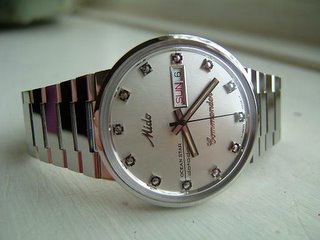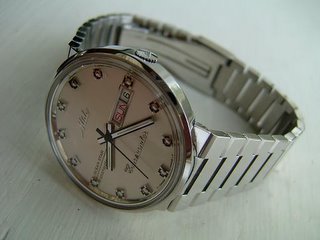



One of the downsides of collecting watches is the price of admission. While it�s true that there are a lot of truly fine poor man's watches out there (and there are folks who can convincingly argue that some examples of these bargain models match their pricier counterparts in all respects), the big names don't come cheap. You like Rolex, Omega, Tag Heuer, etc., bring money and lots of it. A cheap example of one of these will set you back at least six or seven hundred dollars (and that for a quartz model no less), while the good stuff is well up into the thousands of dollars. If, like me, you just don't have that kind of cash to throw around, (my kids and my money go private school), the situation could get really depressing. Fortunately, there is another way go. Take a deep breath, step back and consider the used watch market, or if you like the classier term, vintage market (to make it sound a little less like buying a used car).
It should be noted that even in the vintage market, some brands hold their value so well that there are few bargains to be had. If you are expecting a Rolex for $200 you will be sorely disappointed. Other brands, however, are very reasonably priced and if you take your time and look around, you can do very well. A few words of caution, however. The fact that a watch is old does not mean that it isn't a fake. The reality is that there are fake vintage watches out there (Seamaster 300 fakes aren't uncommon) and it isn't hard to mistake one for the genuine article. Similarly, there are a lot of so-called frankenwatches (a seemingly acceptable watch that is actually an amalgam of several other watches) floating around. The bottom line is that you should make a point of learning something about the vintage watch you are interested in. With the amount of available data online (Omega, for instance, has an online database of its vintage watches and movements) and the existence of enthusiast forums where one can ask an expert a question, researching a vintage watch isn't terribly hard anymore. Other caveats with a vintage watch, don't assume that the water resistance is functioning and expect the lume to be burnt out. Lastly, make sure that you have access to a competent watchmaker. It is reasonable to expect that a vintage watch will need a cleaning if nothing else. If all of this is too much for you, stick with new watches (not that there aren't plenty of fakes there either though).
On to the Omega. This particular model is a 1966 Seamaster DeVille. It is powered by a model 611 hand wound movement with a date display. The watch is a traditional sized man's watch, small by today�s standard at 35mm (including the crown) but it still looks quite good. The watchcase is Omega's Unishell design that opens only through the dial side which can make servicing tricky. The crystal is an acrylic one that fortunately was not scratched. The watchband is a Hadley-Roma that I added for about $25. The Omega was very clean when I got it, and when opened, it had a jeweler's date mark on the inside of the case indicating a servicing had been done two years ago. Not surprisingly, the original lume was not functioning.
The only substantial change that I made to this Omega, aside from adding a strap, was to have the lume re-done by Kent Parks at Everest Watchworks. A non-operative lume on a watch just plain bothers me and
Now none of this would really mean much if I had paid through the nose for this Omega. That, thankfully, was not the case. The total bill for the watch, the re-lume, the new band and a thorough look-see by my jeweler came to about $250. All told a good deal.




